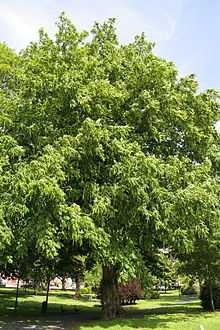Pterocarya fraxinifolia
| Pterocarya fraxinifolia | |
|---|---|
 | |
| Conservation status | |
| Scientific classification | |
| Kingdom: | Plantae |
| (unranked): | Angiosperms |
| (unranked): | Eudicots |
| (unranked): | Rosids |
| Order: | Fagales |
| Family: | Juglandaceae |
| Genus: | Pterocarya |
| Species: | P. fraxinifolia |
| Binomial name | |
| Pterocarya fraxinifolia (Lam.) Spach | |
| Synonyms | |
| |
Pterocarya fraxinifolia is a species of tree in the Juglandaceae family. It is commonly known as the Caucasian wingnut or Caucasian walnut. It is native to the Caucasian region Armenia, Azerbaijan, Georgia, Iran, Russia, the Ukraine and Turkey. It was introduced to France in 1784, and to Great Britain after 1800.[1]
Description
The tree is monoecious and grows to a height of < 30 m, the short, thick bole supporting widely spreading branches to form a rounded structure not unlike the Wych Elm. The pinnate leaves can exceed 60 cm in length, comprising 7 - 27 sessile leaflets. The flowers appear in April, the male catkins thick and green, 7.5 - 12.5 cm long, the females longer with less dense flowers, bearing red styles forming fruiting catkins 30 – 50 cm long, the green, winged, nuts approximately 1.8 cm wide.[2]
Ecology
The species is fast growing and grows best on flat ground or shallow slopes near river banks and in deep moist soils. The climate associated with the distribution of this tree includes mild winters and mild humid summers. It generally grows in mixed stands with other species and rarely grows in pure stands.[3]
- ↑ "Caucasian Wingnut - Keele University Arboretum". Retrieved 2010-10-21.
- ↑ Phillips, R. (1978). Trees in Britain, Europe & North America. Pan Books, London.
- ↑ Sheykholislami, A; T. Ahmadi (2009). "The Study of Caucasian Walnut (Pterocarya frexinifolia (Lam.) Spach.) in Forests of Mashelak (Noshahr, Iran)". Botany Research Journal 2 (2): 28–33.
External links
| Wikimedia Commons has media related to Pterocarya fraxinifolia. |
- Firsov, G.A. 1998. Pterocarya pterocarpa. 2006 IUCN Red List of Threatened Species. Downloaded on 23 August 2007.
